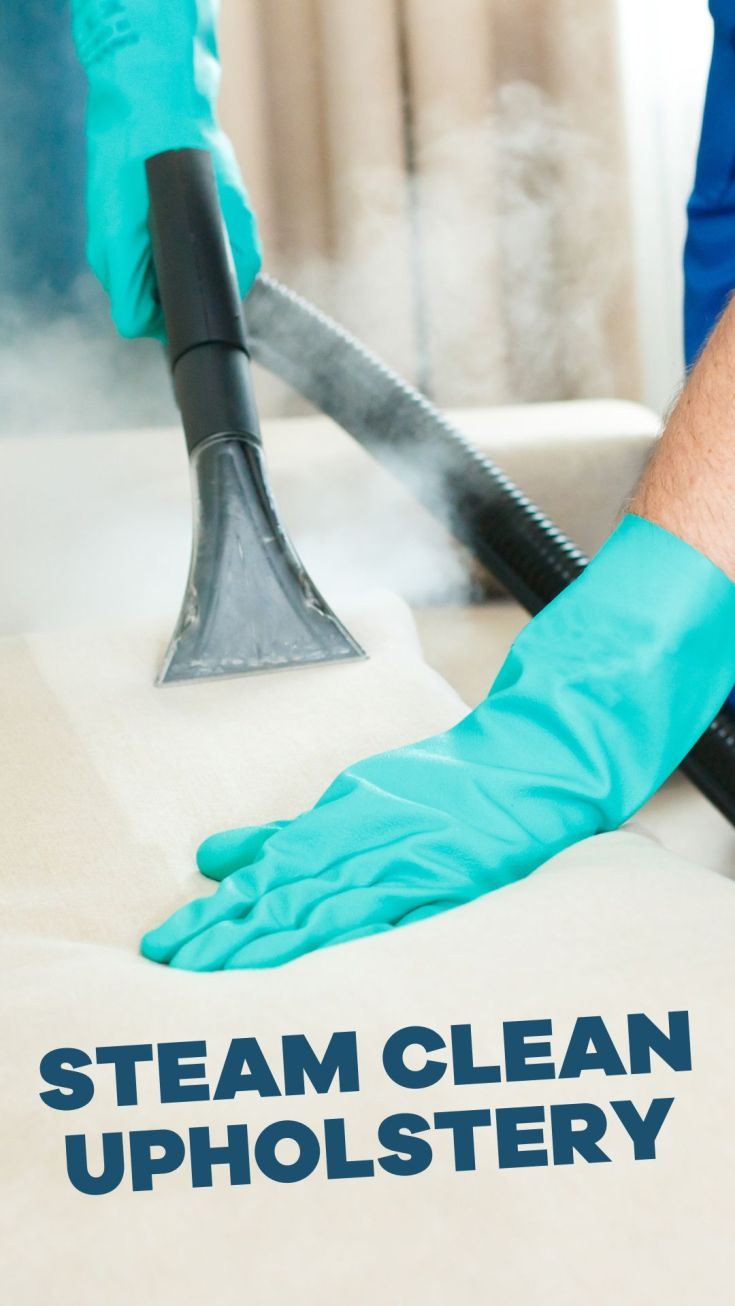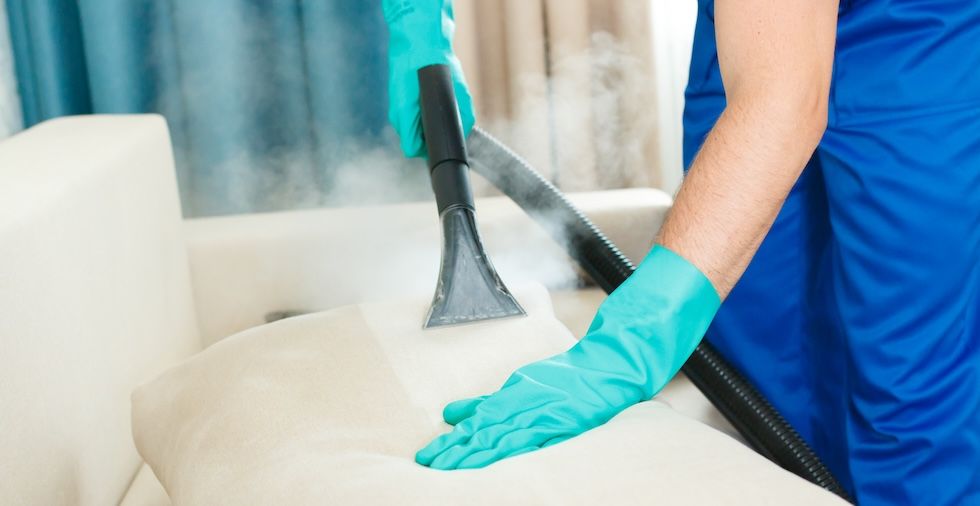- Can you use a steamer to clean upholstery?
- What kind of steamer should you use?
- What you’ll need first
- How to steam clean upholstery: Step-by-step
- Mistakes to avoid when steaming upholstery
Is your sofa looking a little worse for wear? Whether you’ve had a few too many accidental spills or your pets have had accidents, keeping it looking clean and fresh can be a pain. Luckily, there is a quick way to refresh your upholstery without hiring a professional cleaner.
Using a steamer might be the answer. It sounds easy enough. You plug it in, blast the grime away, and the job’s done. But how can you be sure you’ve got it right? And what mistakes should you be avoiding along the way? In this guide, we cover everything you need to know.
Can you use a steamer to clean upholstery?
The short answer is yes, you can. You can safely steam most upholstered furnishings, from sofas and couches to chairs and chaise lounges.
However, not all fabrics are steam-safe. Certain materials, such as velvet, suede, and delicate silks, can be damaged by high temperatures or excessive moisture. For that reason, it’s important to think about the type of upholstery you’re dealing with before you get started.
While care labels aren’t required by law in the UK, many furnishings do have them. The first thing you need to do is check to see if your sofa does. If it doesn’t (and the fabric is delicate), it may be worth avoiding the steamer altogether. It’s better to be safe than sorry.
How Does Steam Cleaning Work?
Before we dive into how you can use a steamer, let’s talk about how it works. Steam cleaning works by using hot vapour to loosen dirt, kill bacteria, and refresh fabrics.
Bonus: It does all of the above without the use of harsh chemicals. It’s an eco-friendly and cost-effective way to get your furniture looking as good as new.
Of course, the upfront cost here is buying or hiring the steamer itself. However, there are steamers for every budget. Be sure to shop around and find one that suits you.
What kind of steamer should you use?
Next up, let’s talk about what kind of steamer you should use. There are a few different types of steamers you can use for upholstery, and each has pros and cons. Let’s take a look at each:
1. Clothes steamer
Best for: Light maintenance and spot-treating fresh spills
Avoid for: Heavy-duty deep cleans or old, set-in stains
Can you use a garment steamer to clean upholstery? Sometimes. While this is an option, it’s not going to get you the same results as others.
A handheld garment steamer is portable and suitable for refreshing surfaces, removing creases, and eliminating odours. It will do a surface-level job. But don’t expect it to deep clean embedded dirt.
2. Handheld steam cleaner
Best for: Chairs, sofas, car seats, and armrests, etc.
Avoid for: Large areas, such as carpets (as it will take all day!)
These compact devices are designed specifically for cleaning small surfaces, such as upholstery and tiles. So, if you’re looking to give your sofa a quick refresh, they are worth your time.
They typically come with fabric-safe nozzles and attachments. Depending on the model you have, you’ll have the chance to play around and see what works for you.
3. Steam mop with upholstery attachment
Best for: All-in-one floor and upholstery cleaning
Avoid for: Delicate (e.g. velvet!) or antique fabrics
Do you already have a steam mop with an upholstery tool? It could be great for multi-purpose use. Before you get started, ensure it’s designed for use with soft furnishings.
To do that, you should check the manufacturer’s guidelines (either online or in the manual!). These are great for floors, and you can use them on large areas, such as sofas. However, you could find that they are tricky to manoeuvre as they tend to be quite clunky.
What you’ll need first
Ready to steam clean your upholstery? Before you begin, gather these items:
- Steam cleaner (see above)
- Clean microfibre cloths
- Vacuum cleaner
- Distilled water
- Lint roller (for any pet hair or fluff)
- Spray bottle (for pretreating stains)
You may also want to get a fabric-safe stain remover to use in combination with the steamer. This is optional, but it can make a big difference when you first start.
Top tip: Avoid using tap water in your steamer. One thing that most people don’t realise is that it can leave mineral deposits and damage the machine.
How to steam clean upholstery: Step-by-step
Now that you have everything you need, you can move on to the steaming process. Here’s how to clean your sofa or chairs with a steamer the right way:
Step 1: Vacuum the surface
First things first, give your upholstery a good vacuum. Use a brush attachment to remove crumbs and dust. This stops debris from turning to mush when you apply steam.
If you have pets that tend to shed fur on your furniture, now’s the time to do something about it. Use a lint roller to get rid of the hair and fluff. This will save you loads of trouble later on.
Step 2: Spot test the fabric
It’s better to be safe than sorry. You’ll want to test a small, hidden area of the fabric with your steamer to ensure it won’t react badly.
Pick a section and use the steamer on it. Next, wait 10–15 minutes to see if there’s any fading, staining, or discolouration. If there’s not, you can use the steamer on the upholstery.
Step 3: Pretreat any tricky stains
Dealing with tricky stains? Use a light mist of fabric-safe stain remover or water on these tough spots. Let it sit for a few minutes and then wipe away.
If you’re using a commercial stain remover, you’ll want to read the label before you get started. Follow the instructions exactly for the best results.
Step 4: Start steaming your upholstery
Now you’re ready to steam your upholstery. Start by attaching the fabric nozzle (if there is one) and begin steaming in slow, overlapping strokes.
Note: You want to keep the nozzle a couple of inches away from the fabric to avoid soaking it. Don’t ever press the nozzle into the fabric. You want the steam to do the work, not the moisture. Keep that in mind.
Step 5: Wipe down the fabric
When you’re finished, you’ll want to wipe away the water from the steam. You can use a clean microfibre cloth to blot away loosened dirt and excess moisture.
Step 6: Let it dry
Air-drying upholstery is the best method. Open windows or put a fan on to get the job done. Make sure your upholstery is completely dry before sitting on it again.
Mistakes to avoid when steaming upholstery
Now that you know how to steam upholstery, let’s take a moment to talk about what you shouldn’t do. Here are some common mistakes that you’ll want to avoid:
Soaking the fabric
If you hold the nozzle too close to the fabric, the steam won’t have a chance to get to it. Instead, you will end up soaking your upholstery, which is a nightmare to dry out.
Steaming delicate fabric
Don’t make the mistake of steaming fabric that is delicate. You might end up ruining your upholstered furnishings.
Failing to vacuum first
If you don’t vacuum your furniture before steaming it, you’re going to end up with a mess. The debris and hair will get stuck to the fabric when you steam it, making it even harder to clean.
Steam cleaning upholstery can be a quick way to freshen up your furniture without spending a fortune on it. Make sure you check the fabric first to see that it’s safe to steam. When you’ve done that, follow our advice and avoid the most common mistakes we’ve highlighted.
Q&A
Did we miss something along the way? Take a look at our frequently asked questions here:
Can you use a garment steamer to clean a couch?
Yes. If you already have a clothing cleaner, you can use it on your sofa, but only for light cleaning jobs. Keep in mind that it won’t remove deep dirt or stains.
Is it safe to steam clean a fabric sofa?
Most of the time, the answer is yes. However, if you’re dealing with delicate fabrics, you might want to think twice about doing so.
How often should I steam my upholstery?
Ideally, you want to steam your upholstery every three to six months to keep it looking fresh. Of course, if you have pets or small children who make a mess, you can do it more often.


Leave a Reply